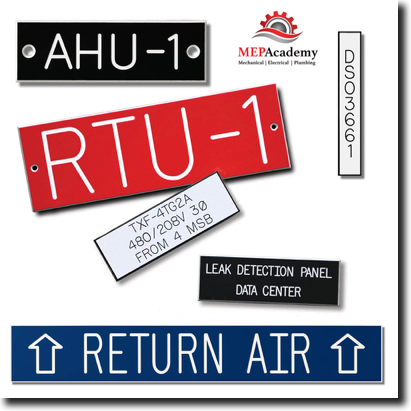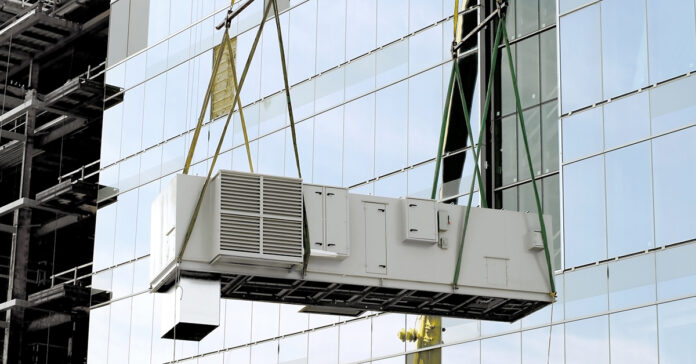Chapter #12 – HVAC Equipment Labor
There are several sources for equipment labor values. But none is better than the contractors own historical data of the actual time required to set a piece of HVAC equipment in place. Below is a list of published data on equipment rigging and setting time. Read carefully the information contained in each reference as to what the labor units include and exclude, so that you can make any necessary adjustments.
MCAA (The Mechanical Contractors Association of America)

MCA publishes labor hours for various pieces of HVAC equipment such as, Air Handlers, Chillers, Pumps, Cooling Towers and accessories. Each category of HVAC equipment has a range of sizes with varying amounts of labor required to set in place. Depending on the geographical location of your project, you will apply a factor to these values. Members get access to their online database of labor.
SMACNA (Sheet Metal and Air Conditioning Contractors National Association)

SMACNA publishes labor units for sheet metal duct and fittings in addition to certain HVAC equipment and accessories based on National averages. Air Conditioning Units, Coils, Fans, Filters, Sound Traps and miscellaneous items are available with various units of labor based on the size and or weight of the item. The SMACNA labor manual also provides a means to adjust labor based on difficult and very difficult conditions. The labor data was derived from surveys of sheet metal and air conditioning contractors in the United States and Canada, which included data from actual projects.
RS Means (Gordian)

Gordian publishes material and labor values for a wide range of construction components and assemblies for all trades. Many municipalities use the Gordian system for their procurement of construction services. The material and labor database is maintained and updated regularly by the Gordian Group.
PHCC (Plumbing-Heating-Cooling Contractors Association)

PHCC publishes labor data which you can purchase. Their database covers a wide range of pipe, valves and fittings in addition to some equipment.
Company Historical Data
Historical Data that your company keeps from projects that have been completed is the best data available for your estimates. The problem is that most companies done take the time or effort to document these values, so they will need to rely on one or more of the industry published databases mentioned above for their benchmark labor.
If your company doesn’t keep track of the time it takes to rig and set in place the various pieces of HVAC equipment, I would suggest starting such effort in order to understand what it takes in the way of man hours and effort. It doesn’t matter what some industry database says it should take if your company can do it faster or slower than the published productivity rate. So begin to establish a company standard with the cooperation of your project managers and field personnel to record the time it takes to rig and set equipment and the various factors and conditions involved.
Basic Assumptions in Published Labor Databases
The industry published labor data for the time required to rig and set HVAC equipment is based on certain assumptions which are usually listed at the beginning of their labor manuals. Be sure to read any of the footnotes (MCA) or Correction Factors (SMACNA) on any of the equipment labor tables contained within these industry databases, as they will indicate any additional conditions or assumptions to be aware of. Assumptions might include some of the following which you should be thinking about when you go to labor the equipment and accessories.
Part of the process of dealing with equipment and accessories is the unloading, stockpiling, assembling, erecting and preparing the equipment for startup and testing. Depending on how your company prefers to allocate their labor, there might be a separate category of labor called material handling in which different pay rates are utilized.
Things to Consider When Figuring Equipment Labor
Location of Equipment
The industry equipment labor databases assume that the equipment will be within a certain distance from where it is to be installed, such as with MCA it’s assumed to be received within 100 feet from its final destination.
Size and Weight of HVAC Equipment
Equipment that weights under 250 Lbs (per MCA) is considered to be handled by a two person crew with the use of chain falls, hi-jacks or similar tools.

Equipment that is over 250 Lbs might require a Roustabout, chain falls, crane, forklift, lift jacks, rollers, etc. to move them and get them in place. Below is a Genie Lift with varying capacity based on the model you own.

How heavy is the equipment? Cooling Towers, Chillers, Large Boilers and Air Handlers will require rigging by a crane, forklift or helicopter depending on its location in the building or on the roof. Is the physical size of the equipment too large to be handled safely by workers? Will you need equipment rollers or the use of a hoist? Does the equipment come in several pieces in order for it to fit on a truck from the factory?

You must become familiar with each piece of equipment and what is required to get it rigged and set in the location shown on the drawings. Is the equipment located indoors or outdoors?
Access to Equipment Location
- How will the equipment get into its designated location?
- If it is an existing building will the equipment fit in the service elevator or through doorways to its final resting spot?
- Does the equipment easily breakdown into smaller pieces for rigging?
- Is there room for a crane to setup on the side of the building closet to the equipment?
- Do you need a street closer permit in order to block traffic during the rig so the crane can setup in the street?
- Are there electrical overhead wires preventing a crane from operating in the area?
- Do you need a helicopter?
- Do you have to move other equipment or services to get your equipment in position?
Above are just a few of the things to think about when laboring equipment. You will need to adjust the standard labor based on the perceived risk and jobsite conditioned expected to be encountered during construction.
Method of Support
Is the equipment hung from above or set on the floor or roof? Does the equipment sit on vibration isolation? Do you need to build a support frame to hold the equipment, or does the equipment come with its own supports? Are seismic restraints required, as they add additional time to your equipment setting labor because of the additional time to install the restraints? Look at the detail pages on the drawings to find any engineered attachment or support methods.
Equipment Accessories
Does the equipment come with parts unattached for field assembly? Large filter racks need to be built up in place and then have their filters inserted. Sound traps can come with many modules needing assembling. Economizers are sometimes shipped loose and need to be attached. Backdraft dampers and roof curbs for exhaust fans. Vibration isolators for all types of equipment are a separate component that gets installed with the equipment. Cooling towers have ladders, motor davits and vibration isolators that ship separately.

Multiple Pieces
Does the equipment come in several pieces because they are too large to ship in one piece, or are too large to fit through an existing doorway? Air handlers can be shipped broken down into fan, coil and filter sections all separated for easy shipment and field assembly. Cooling towers and fluid coolers also come in multiple sections. Talk to your vendor about how they plan to ship any large equipment that could possibly come in multiple pieces.
Crew Size
How many men are required to rig and set in place each piece of equipment? Composite crews made up of piping and sheet metal union workers will set anything that has piping and sheet metal attached to it, each union claiming a part of the work. As such, any piece of equipment that has only sheet metal attached will be claimed by the sheet metal union and vice versus for the piping union. If you work for a non-union company then worrying about jurisdictional labor allocation isn’t a problem. (See chapter on Labor Crew Size)
What Information Should You Record
Most of the information that you will need to labor the equipment can be found on the equipment schedule of the plans and specifications, or from the equipment submittal of the manufacture. Below is a list of a few items and what characteristics you might list for each piece of equipment on your estimating spreadsheet to help you provide a value for labor.
Air Compressors: List the HP (Horsepower), Receiver Capacity, Dimensions and Weight.
Air Conditioners: List the type, Tons, CFM (Cubic Feet per Minute), Dimensions and Weight. Types might include “Self-Contained”, “Water-Cooled Vertical”, “Packaged Rooftop Gas/Electric”
Air Handlers: List the type, CFM, Dimensions and Weight. Types may include Multi-Zone, Floor or Ceiling mounted, Custom, Roof Mounted.
Boilers: List the Type, HP (horse power), If steam Lbs/Hr, BTUH (BTU per Hour), Weight.
Chemical Feeders: Tank Capacity, size and weight
Chillers: Type, Tons, Air or Water-Cooled, Accessories
Coils: Type, Area FT2, Dimensions, rows of coils and weight.
Compressors: Type, Tons and weight
Condensate Return System: GPM (Gallons per Minute), Dimension and weight.
Condensers: Type, Tons, Dimensions and weight
HVAC Equipment Tab – Estimating Spreadsheet
Equipment labor should be applied to every piece of equipment and accessories that the field labor will be required to rig and anchor in place, whether fasten to the ground or hung in the air, or sitting on the roof. Your estimating spreadsheet should allow for conveniently allocating hours for each piece of equipment alongside its pricing.

HVAC contractors can provide both the sheet metal and HVAC piping requirements for a project. Some pieces of equipment will require a composite labor crew; especially if they’re a union company with define roles for each trade. Equipment that has water or refrigerant connected to it along with sheet metal may require a composite labor crew.
Enter the quantity and description of the equipment, and then enter the unit of labor required for each piece of equipment. If you have four (4) Rooftop Upblast Exhaust Fans that sit on a roof curb, you might enter 4 hours each if they’re smaller units, which would give you a total of 16 sheet metal hours for the 4 small exhaust fans.
Retrofit Projects
If you are bidding on a project that is within an existing building, then you will need to consider additional labor items. Ducts and pipes will need to be disconnected from the HVAC equipment. Water will need to be drained out of any pipes connected to any equipment receiving any form of water or steam service.
To get large pieces of equipment out of existing spaces, often requires that it be taken apart or cut into pieces. If your company doesn’t do this type of work, there are specialty companies that you can subcontract this work to. If you are bidding on a turn-key project, one in where your company is responsible for all trades, then you will need to get other companies involved, this usually occurs under the design/build method of construction contracts.
What’s Not Included in the Labor Units
Start Up & Testing of Equipment
The time for startup and testing is a separate labor task that is usually done by trained technicians different than those installing the equipment. These specialized individuals are familiar with the procedures and documentation required for starting up and testing HVAC equipment.
Air and Water Balance
Often the specification will require a third party to perform the air and water balancing in order to avoid conflicts of interest that occur when the contractor self performs this work. Typically the specifications will call for the Air and Water Balance Company to use NEBB or ABBC certified technicians to perform the work.
Equipment Identification
Each piece of HVAC, Plumbing or Electrical equipment will get an identification tag that identifies what the equipment is, along with some of its capacity information and possibly the area it serves.

There will be a unit cost for material and labor for every equipment ID tag. A field laborer will need to fasten the equipment tag somewhere visible to the maintenance staff when accessing the equipment. The background and lettering color maybe dictated by the specifications and is often provided on some form of laminated plastic. Put this requirement on the sheet metal specialties tab of your estimating spreadsheet. (see chapter on Sheet Metal Specialties)

Get a copy of the MEP Academy Estimating Spreadsheet.

Sheet Metal Field Installation Course
- Chapter #1- Rectangular Duct and Fittings
- Chapter #2 – Round Ductwork and Fittings
- Chapter #3 – Sheet Metal Duct Hangers
- Chapter #4 – Sheet Metal Field Labor Productivity
- Chapter #5 – Labor Crew Sizes
- Chapter #6 – Sheet Metal Duct Sealer
- Chapter #7 – Sheet Metal Details and Specialties
- Chapter #8 – Grease Exhaust
- Chapter #9 – Air Distribution
- Chapter #10 – Rental Equipment
- Chapter #11 – Conditions Affecting Field Labor
- Chapter #12 – HVAC Equipment Labor







